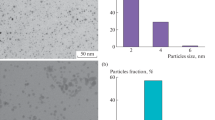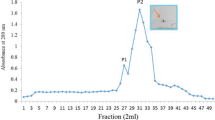Summary
Kidney and liver samples from two cases of Fabry's disease and spleen and liver samples from Gaucher and Niemann—Pick diseases were tested for binding to lectins such as peanut agglutinin (PNA),Bandeiraea simplicifolia, (BSA),canavalia ensiformis (Con A), soybean agglutinin (SBA) and wheat germ agglutinin (WGA) labelled with horseradish peroxidase using histochemical techniques. These techniques allowed the localization of compounds with α-galactosyl residues in tissues from Fabry's disease. In tissues from the Gaucher and Niemann—Pick cases, the storage material was found to be more complex than expected, and some problems regarding the significance of lectin binding are discussed.
Similar content being viewed by others
References
ALROY, J., UCCI, A. A., GOYAL, V. & WOODS, W. (1986) Lectin histochemistry of glycolipid storage diseases on frozen and paraffin-embedded tissue sections.J. Histochem. Cytochem. 34, 501–5.
FARAGGIANA, T., CHURG, J., GRISHMAN, E., STRAUSS, L., PRADO, A., BISHOP, D. F., SCHUCHMAN, E. & DESNICK, R. J. (1981) Light- and electronmicroscopic histochemistry of Fabry's disease.Amer. J. Pathol. 103, 247–62.
FARAGGIANA, T., MALCHIODI, F., PRADO, A. & CHURG, J. (1982) Lectin—peroxidase conjugate reactivity in normal human kidney.J. Histochem. Cytochem. 30, 451–8.
HARZER, H., ANZILZ, P. & SCHUSTER, I. (1977) Resolution of tissue sphingomyelinase isoelectric profile in multiple components is extraction dependent: evidence for a component defect in Niemann—Pick disease type C is spurious.J. Neurochem. 29, 1155–7.
HOLTHÖFER, H., VIRTANEN I., PETTERSON, E., TÖRNROTH, T., ALFTHAN, O., LINDER, E. & MIETTINEN, A. (1981) Lectins as fluorescence microscopic markers for saccharides in the human kidney.Lab. Invest. 45, 391–9.
HUBBARD, A. L., WILSON, G., ASHWELL, G. & STUKENBROK, H. (1979) An electron microscope autoradiographic study of the carbohydrate recognition systems in rat liver.J. Cell Biol. 83, 47–64.
PETERS, B. P. & GOLDSTEIN, I. J. (1979) The use of fluorescein-conjugatedBandeiraea simplicifolia B4 isolectin as a histochemical reagent for the detection of α-d-galactopyranosyl groups.Exp. Cell Res. 120, 321–34.
VIERBUCHEN, M., KLEIN, P. J., UHLENBRUCK, G., KLEIN, H. O., SCHAEFER, H. E. & FISCHER, R. (1980) The significance of lectin receptors in the kidney and in hypernephroma (renal adenocarcinoma). InRecent Results in Cancer Research, pp. 68–75. Berlin: Springer Verlag.
Author information
Authors and Affiliations
Rights and permissions
About this article
Cite this article
Lageron, A. Characterization by lectin binding of the sugar moiety of glycocompounds stored in inherited diseases. Histochem J 19, 419–425 (1987). https://doi.org/10.1007/BF01675752
Received:
Revised:
Issue Date:
DOI: https://doi.org/10.1007/BF01675752




